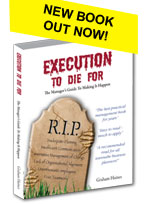2.2.3 Cultural Change - IBM - Win, Execute, Team
I’ve read a lot of business books over the years and I’ve developed a preference for those based on people’s personal experiences of running well-known companies and organisations. The amount of highlighting and the number of Post-it notes protruding from its pages indicate the worth of the book. A few are so good that they are referred to repeatedly.
One such book is “Who says elephants can’t dance?” by Lou Gerstner who replaced John Akers at IBM as its CEO and over a period of nine years from 1993 – 2002 engineered IBM’s turnaround from a loss of $8 billion to a profit of roughly the same amount.
It’s a fascinating and instructive story of IBM’s competitive and cultural transformation and Gerstner makes the point that transforming IBM’s culture was the biggest – and the most crucial – task that he undertook. He explains how founder Tom Watson’s “Basic Beliefs” – Excellence in everything we do, Superior customer service and Respect for the individual had been the cultural foundation stone for the Company’s success until the early 90’s only to become the millstone that nearly drowned it.
The way in which these Basic Beliefs came to be interpreted and acted upon by IBM’s 300,00 employees resulted in excruciatingly slow decision-making, a “we know best” attitude to customer service and an obsession with personal status and the perks of office. Respect for the individual manifested itself as an acceptance of anyone’s right to say “no” to a course of action.
As a consequence, internal competition between individuals, business units and divisions was taken far more seriously than competition between IBM and its rivals in the market place.
This is no place to list all the initiatives that Gerstner took to change the corporate culture but I must make mention of his work on “Leadership Competencies”. After initially drawing up a list of11 competencies under the three headings of “Focus to win”, “Mobilise to execute” and “Sustain momentum”, he felt that after a couple of years momentum was stalling. Too many IBMers paid lip service to the “New Blue” but continued to work as if they were still in the old IBM.
So Gerstner did two things. First, he reduced the competencies to just three – Win, Execute, Team. Each was given a specific meaning.
- Win - business is a competitive activity
There are winners and losers. In the new IBM, there is no place for anyone who lacks zeal for the contest. Most crucially, the opponent is in the market place, not within IBM. Competing in the marketplace is the driving criterion for all of our actions and all of our behaviour
- Execute - this is all about speed and discipline
There would be no more of the obsessive perfectionism that caused IBM to miss market opportunities and let others capitalise on IBM’s discoveries. No more studying things to death. In the new IBM, successful people would commit to getting things done – fast and effectively.
- Team
Tthis was a commitment to acting as one IBM, to teamwork between individuals, between workgroups, between divisions – plain and simple.
The second thing he did was to integrate Win, Execute, Team into the new Performance Management System. Each year, IBMers had to make three Personal Business Commitments related to Win, Execute and Team and then list the actions that they were going to take to fulfil the commitments. Performance against those commitments was a key determinant of merit and variable pay. As Gerstner says several times in the book, people do what you inspect not what you expect.
Gerstner is one of those rare CEO’s who possessed the capacity to not only save a company from bankruptcy but to rebuild it so it surpassed its former glory. Perhaps the best measure of IBM’s performance over the years of his tenure is the share price that rose from $12.72 in March 1993 to $120.96 in December 2001. For the greater part, the transformation is straight from the textbook but like a reforming CEO that I once worked for, Gerstner understood the impact that small actions have in reinforcing the message that – like it or not – things are going to change.
Part of the culture of the old IBM was the obsessive use of overheads when making internal presentations. At one of Gerstner’s first meetings on the state of the computer hardware business, the speaker was on his second overhead when Gerstner got up and quietly switched off the projector and, after a pause, said “let’s just talk about your business”.
By the end of that day, there were not too many IBM executives around the world that had not heard the story. “Talk about consternation! It was as if the President of the United States had banned the use of English at White House meetings,” Gerstner recalled.
Most IBMers welcomed the new culture of Win, Execute and Team. However, there were a significant number of executives who, whilst they recognised the crisis that faced IBM and supported, reluctantly in some cases, the strategies devised to re-establish IBM’s reputation and profitability, could not stomach the organisational and cultural reforms. They left the Company.
There’s a message there. Try to win people over to change but if they do not demonstrate their conversion through their actions and performance, don’t keep them. The damage that a few people can do to a change program through a campaign of passive and covert resistance is enormous.
Win, Execute, Team. Could you use it in your company?






